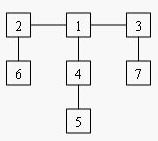Description
Consider a tree T with N ((1 le N le 20,000)) nodes numbered (1...N). Deleting any node from the tree yields a forest: a collection of one or more trees. Define the balance of a node to be the size of the largest tree in the forest T created by deleting that node from T.
For example, consider the tree:

Deleting node 4 yields two trees whose member nodes are ({5}) and ({1,2,3,6,7}). The larger of these two trees has five nodes, thus the balance of node 4 is five. Deleting node 1 yields a forest of three trees of equal size: ({2,6}, {3,7}), and ({4,5}). Each of these trees has two nodes, so the balance of node 1 is two.
For each input tree, calculate the node that has the minimum balance. If multiple nodes have equal balance, output the one with the lowest number.
Input
The first line of input contains a single integer t ((1 le t le 20)), the number of test cases. The first line of each test case contains an integer N ((1 le N le 20,000)),the number of congruence. The next N-1 lines each contains two space-separated node numbers that are the endpoints of an edge in the tree. No edge will be listed twice, and all edges will be listed.
Output
For each test case, print a line containing two integers, the number of the node with minimum balance and the balance of that node.
Sample Input
1
7
2 6
1 2
1 4
4 5
3 7
3 1
Sample Output
1 2
Resume
定义树上节点的balance为删除该点后产生的森林中最大的树的节点数,求给定树的所有节点的balance的最小值。
Analysis
建图,转化成有根树,然后树形dp。
设(size[i])为以节点(i)为根的子树节点数,(f[i])为节点(i)的balance值。则状态转移方程为$$f[i] = max(N-size[i],max_{j in s[i]}size[j]) quad ext{where (s[i]) is the set of the son nodes of node i.}$$也就是说每一个节点的balance值是 其上方节点数之和 与 所有以子节点为根的子树节点数 中的最大值。在遍历过程中记录最小的balance值即可。
技巧:通过BFS转化为有根树时产生的队列可以作为dp顺序使用。
Code
//////////////////////////////////////////////////////////////////////
//Target: POJ 1655 - Balancing Act
//@Author: Pisceskkk
//Date: 2019-2-21
//////////////////////////////////////////////////////////////////////
#include<cstdio>
#include<cstring>
#define N (int)2e5+10
#define INF 1e9
#define Max(a,b) (a>b?a:b)
using namespace std;
int t,n,s[N],ans[N],min_i,min_b;
int q[N],d[N];
int he[N];
struct edge{
int to,ne;
}e[N<<1];
void add_2(int x,int y,int i){
i<<=1;
e[i].ne = he[x];
he[x] = i;
e[i].to = y;
i++;
e[i].ne = he[y];
he[y] = i;
e[i].to = x;
}
int bfs(int s){
int h=0,t=0;
memset(d,0,sizeof(d));
memset(q,0,sizeof(q));
q[h++]=s;
d[s] = 1;
while(t<h){
int x=q[t++],y;
for(int i=he[x];i;i=e[i].ne){
y = e[i].to;
if(!d[y]){
d[y] = 1;
q[h++]=y;
}
}
}
return h;
}
int main(){
scanf("%d",&t);
while(t--){
memset(e,0,sizeof(e));
memset(he,0,sizeof(he));
memset(s,0,sizeof(s));
memset(ans,0,sizeof(ans));
min_i = min_b = INF;
scanf("%d",&n);
int x,y;
for(int i=1;i<n;i++){
scanf("%d %d",&x,&y);
add_2(x,y,i);
}
bfs(1);
for(int i=n-1;i>=0;i--){
int x = q[i];
s[x] = 1;
for(int i=he[x];i;i=e[i].ne){
y = e[i].to;
s[x] += s[y];
ans[x] = Max(ans[x],s[y]);
}
ans[x] = Max(ans[x],n-s[x]);
if(ans[x] < min_b){
min_b = ans[min_i=x];
}
else if(ans[x] == min_b && x < min_i){
min_i = x;
}
}
printf("%d %d
",min_i,min_b);
}
}